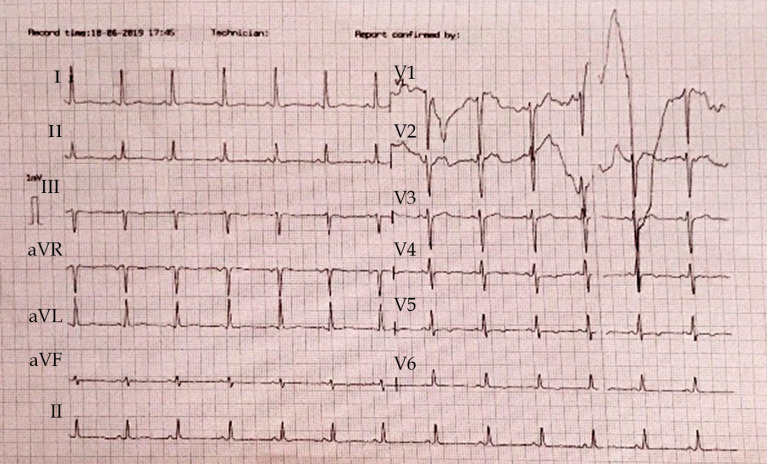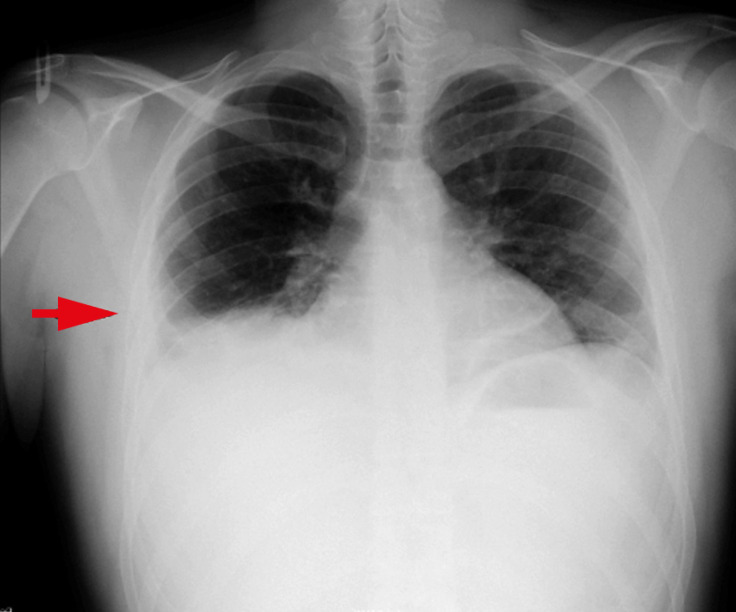Abstract
The basic components of energy drinks include caffeine, guarana, taurine, ginseng, and sugar. The excessive consumption of energy drinks has been associated with cardiovascular events such as tachycardia and myocardial infarction in the literature. We herein describe a 24-year-old man admitted to the emergency department. The patient’s medical history and family history were unremarkable. It was, however, learned that he had consumed 8 to 10 cans of energy drinks per day (3.5–4 Lit/d) in the 2-week period leading to the hospital admission. Physical examination revealed bilateral diffuse rales and 2+ pretibial edema. Echocardiography showed a left ventricular ejection fraction of 25% with global left ventricular hypokinesia and dilated left ventricular dimensions. Coronary angiography demonstrated normal coronary arteries. On cardiac magnetic resonance imaging, the left ventricle was dilated, and the systolic function was reduced. No pathological enhancement was observed. This case report and many previous studies support a possible link between caffeinated energy drinks and cardiovascular events.
Key Words: Energy drinks; Cardiomyopathy, dilated; Heart failure
Introduction
The uncontrolled consumption of energy drinks is becoming widespread in the young population.1 The basic components of energy drinks include caffeine, guarana, taurine, ginseng, carnitine, ginseng, vitamin complexes, and sugar.2 In the literature, the excessive consumption of energy drinks has been associated with cardiovascular events such as tachycardia, myocardial infarction, and death.3, 4 The tachycardic and arrhythmic effects of energy drinks have been proven by some well-designed studies.5 Peake et al6 described a case of atrial fibrillation and dilated cardiomyopathy after the excessive consumption of energy drinks. A recent case report described a patient with biventricular cardiomyopathy in sinus rhythm.7 Still, evidence is scarce regarding the association between energy drinks and acute heart failure and cardiomyopathy. Our case report indicates that energy drinks, which are often associated with arrhythmias and coronary events, also cause chronic heart failure.
Case Report
A 24-year-old man was admitted to the emergency department with complaints of dyspnea, which had gradually increased over the preceding week. The patient’s medical history and family history were unremarkable. It was, however, learned that he had consumed 8 to 10 cans of energy drinks per day (3.5–4 L/d) in the 2-week period leading to the hospital admission. He stated that he had developed dyspnea and fatigue 3 days after he first consumed an energy drink. Physical examination revealed orthopnea, bilateral diffuse rales, and 2+ pretibial edema. Electrocardiography (ECG) showed sinus rhythm, a heart rate of 110 beats per minute, and T-wave inversion in leads V4 to V6 (Figure 1).
Figure 1 .
The admission electrocardiogram shows sinus rhythm.
Chest X-ray demonstrated a consolidated area in the right lower zones (Figure 2).
Figure 2 .
The chest X-ray shows pleural effusion accumulating in the inferior zone of the right lung (arrow) secondary to heart failure.
Thorax computed tomography revealed pulmonary edema and pleural effusion. Echocardiography showed a left ventricular ejection fraction of 25%, an end-diastolic diameter of 62 mm, an end-systolic diameter of 52 mm, an interventricular septum of 7 mm, and a posterior wall of 6 mm, with global left ventricular hypokinesia and dilated left ventricular dimensions (Figure 3).
Figure 3 .
The echocardiogram in the parasternal long-axis view shows an increased left ventricular diastolic diameter.
The right ventricular dimensions and functions were normal. The patient was diagnosed with acute heart failure and was, therefore, hospitalized. The etiologic investigation was performed after diuretic treatment and symptom relief. Coronary angiography demonstrated normal coronary arteries. Two months after the diagnosis, cardiac magnetic resonance imaging revealed an ejection fraction of 26%, an interventricular septum of 7 mm, an end-diastolic volume of 229 mL, an end-systolic volume of 169 mL, a stroke volume of 60.5 mL, and a cardiac output of 4.3 mL. Additionally, the left ventricle was dilated, and the systolic function was reduced. No pathological enhancement was observed (Figure 4).
Figure 4 .
The cardiac magnetic resonance imaging in the 2-chamber long-axis view shows a dilated left ventricle. Late gadolinium enhancement is not seen. LA, Left atrium; LV, Left ventricle
Right ventricular functions were normal in cine imaging. Six months later, there was no improvement in echocardiographic parameters at the control visit.
Discussion
The excessive consumption of energy drinks has been associated with life-threatening neurological and cardiovascular complications.2 From a neurological point of view, several seizure cases have been reported.2 Vis-à-vis the cardiovascular system, palpitations, arrhythmias, and coronary events comprise the most frequently reported cases.2 The recommended maximum daily dose of caffeine is 400 mg/d, with caffeine levels of 4 g/d and 10 g/d considered toxic and lethal, respectively. Over the past decades, the cardiac effects of caffeine have been extensively studied and seen as the main cause of tachyarrhythmias, increased blood pressure, decreased vasodilatation, and new-onset atrial fibrillation.8 Guarana, another low-amount ingredient, has been used as a cardiac stimulator since ancient times.9 Guarana contains xanthine alkaloids, like theobromine and theophylline, and more caffeine than coffee beans.10 This explains why more cardiovascular adverse events occur in energy drinks with Guarana.2 Nevertheless, whereas taurine triggers atrial and ventricular arrhythmias by shortening the action potential,10 L-carnitine has been shown to reduce angina and ventricular arrhythmias.11 These 2 amino derivatives with reverse effects are found together in energy drinks. In addition to the main ingredients described above, energy drinks contain vitamin complexes and carbohydrate derivatives such as glucuronolactone and fructose. Another popular additive is ginseng, which is used to enhance performance. Ginseng has a hypoglycemic effect in contrast to its carbohydrate content.12 Unlike the carbohydrate and other ingredients of energy drinks, ginseng has a hypoglycemic effect.12 Alcohol and other concomitant medications can potentiate the effects of energy drinks. The combination of alcohol and caffeine increases the half-life of caffeine by 72%.13 Most manufacturers do not label the exact amount of compounds in energy drinks. These substances, which are far below the therapeutic level, may show synergic interactions in excessive use. It is controversial to determine which ingredients are responsible for adverse cardiac effects.
Our patient was a social drinker. However, he did not report the use of concomitant vasospastic etiologies such as cocaine. We excluded Prinzmetal’s angina and hypertrophic cardiomyopathy. Myocarditis is another cause of acute heart failure, with viral infection constituting the most common etiology. Generally, improvement in cardiac functions is expected after the acute infective phase. We assessed the patient’s immunological and rheumatological biomarkers, namely antinuclear antibodies (ANAs), the rheumatoid factor (RF), anti-cyclic citrullinated peptide (anti-CCP), and the anti–double-stranded DNA (anti-ds-DNA), but we found no clues to explain the etiology. The patient had no history of allergies, and we could not detect eosinophilia. Another possible cause was tachycardia-induced cardiomyopathy; accordingly, we placed the patient under rhythm Holter monitoring for 96 hours. No dysrhythmia was detectable. However, his admission ECG was in sinus rhythm; and despite the rate control and optimal medical treatment, there was no improvement in ejection fraction at 6 months’ follow-up. Endomyocardial biopsy, which is the gold standard in the diagnosis of cardiomyopathy, could be helpful with the differential diagnosis. The diagnosis of left ventricular myocardial disease, especially with restrictive and infective causes, can be made with biopsies from the interventricular septum. Unfortunately, our center is not experienced in endomyocardial biopsies. Further, Löffler syndrome, myocarditis, and noncompaction can be ruled out by well-synchronized cine cardiac magnetic resonance imaging and the evaluation of gadolinium enhancement. It is worthy of special attention that before we linked this case with energy drinks, we performed all diagnostic modalities except a biopsy.
Conclusion
This case report and some previous studies support a possible link between caffeinated energy drinks and cardiovascular events. Physicians should be aware of the risk of cardiomyopathy and arrhythmogenicity associated with the energy drink, and the use of these products should be questioned, especially in the young age group with unexplained heart failure. Further studies are required to better understand the relationship between energy drink consumption and cardiomyopathy.
Notes:
This paper should be cited as: Uyanik M, Gedikli O, Yildirim U. Energy Drink-Associated Cardiomyopathy after Excessive Consumption: A Case Report. J Teh Univ Heart Ctr 2021;16(3):119-122.
References
- 1.Reissig CJ, Strain EC, Griffiths RR. Caffeinated energy drinks--a growing problem. Drug Alcohol Depend. 2009;99:1–10. doi: 10.1016/j.drugalcdep.2008.08.001. [DOI] [PMC free article] [PubMed] [Google Scholar]
- 2.Wassef B, Kohansieh M, Makaryus AN. Effects of energy drinks on the cardiovascular system. World J Cardiol. 2017;9:796–806. doi: 10.4330/wjc.v9.i11.796. [DOI] [PMC free article] [PubMed] [Google Scholar]
- 3.De Sanctis V, Soliman N, Soliman AT, Elsedfy H, Di Maio S, El Kholy M, Fiscina B. Caffeinated energy drink consumption among adolescents and potential health consequences associated with their use: a significant public health hazard. Acta Biomed. 2017;88:222–231. doi: 10.23750/abm.v88i2.6664. [DOI] [PMC free article] [PubMed] [Google Scholar]
- 4.Wolk BJ, Ganetsky M, Babu KM. Toxicity of energy drinks. Curr Opin Pediatr. 2012;24:243–251. doi: 10.1097/MOP.0b013e3283506827. [DOI] [PubMed] [Google Scholar]
- 5.Dobmeyer DJ, Stine RA, Leier CV, Greenberg R, Schaal SF. The arrhythmogenic effects of caffeine in human beings. N Engl J Med. 1983;308:814–816. doi: 10.1056/NEJM198304073081405. [DOI] [PubMed] [Google Scholar]
- 6.Peake ST, Mehta PA, Dubrey SW. Atrial fibrillation-related cardiomyopathy: a case report. J Med Case Rep. 2007;1:111. doi: 10.1186/1752-1947-1-111. [DOI] [PMC free article] [PubMed] [Google Scholar]
- 7.Fisk G, Hammond-Haley M, D'Silva A. Energy drink-induced cardiomyopathy. BMJ Case Rep. 2021;14:e239370. doi: 10.1136/bcr-2020-239370. [DOI] [PMC free article] [PubMed] [Google Scholar]
- 8.Papamichael CM, Aznaouridis KA, Karatzis EN. Effect of coffee on endothelial function in healthy subjects: the role of caffeine. Clin Sci (Lond) 2005;109:55–60. doi: 10.1042/CS20040358. [DOI] [PubMed] [Google Scholar]
- 9.Smith N, Atroch AL. Guaraná’s journey from regional tonic to aphrodisiac and global energy drink. Evid Based Complement Alternat Med. 2010;7:279–282. doi: 10.1093/ecam/nem162. [DOI] [PMC free article] [PubMed] [Google Scholar]
- 10.Patrick M, Kim HA, Oketch-Rabah H, Marles RJ, Roe AL, Calderón AI. Safety of Guarana seed as a dietary ingredient: a review. J Agric Food Chem. 2019;67:11281–11287. doi: 10.1021/acs.jafc.9b03781. [DOI] [PubMed] [Google Scholar]
- 11.DiNicolantonio JJ, Lavie CJ, Fares H, Menezes AR, O'Keefe JH. L-carnitine in the secondary prevention of cardiovascular disease: systematic review and meta-analysis. Mayo Clin Proc. 2013;88:544–551. doi: 10.1016/j.mayocp.2013.02.007. [DOI] [PubMed] [Google Scholar]
- 12.Attele AS, Zhou YP, Xie JT, Wu JA, Zhang L, Dey L, Pugh W, Rue PA, Polonsky KS, Yuan CS. Antidiabetic effects of Panax ginseng berry extract and the identification of an effective component. Diabetes. 2002;51:1851–1858. doi: 10.2337/diabetes.51.6.1851. [DOI] [PubMed] [Google Scholar]
- 13.Goldfarb M, Tellier C, Thanassoulis G. Review of published cases of adverse cardiovascular events after ingestion of energy drinks. Am J Cardiol. 2014;113:168–172. doi: 10.1016/j.amjcard.2013.08.058. [DOI] [PubMed] [Google Scholar]






